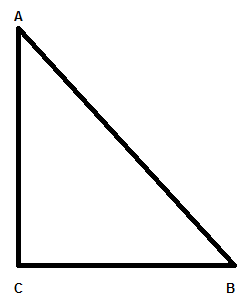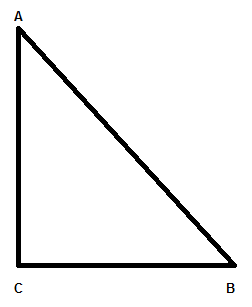
In the given figure, ABC is an isosceles right triangle, right-angled at C. Prove that $A{{B}^{2}}=2A{{C}^{2}}$.


Answer
605.7k+ views
Hint: Two sides of an isosceles triangle is equal. Pythagoras theorem can be given as ${{\left( \text{hypotaneous} \right)}^{\text{2}}}\text{=}{{\left( \text{base} \right)}^{\text{2}}}\text{+}{{\left( \text{perpendicular} \right)}^{\text{2}}}$. Using these two things the desired result can be obtained.
Complete step-by-step answer:
We have an isosceles triangle ABC with$\angle C={{90}^{o}}$ and hence sides AC and BC are equal to each other, as in isosceles triangle two sides are equal. Hence, diagram of $\Delta ABC$can be represented as

Where AC = BC and $\angle C={{90}^{o}}$
Now, we need to prove the relation given as
$A{{B}^{2}}=2A{{C}^{2}}$ ………………….. (i)
So, let us calculate the value of $A{{B}^{2}}$in terms of $A{{C}^{2}}$to prove the above equation (i).
As we know any right angle triangle will follow the Pythagoras property which can be given as
${{\left( \text{hypotaneous} \right)}^{\text{2}}}\text{=}{{\left( \text{base} \right)}^{\text{2}}}\text{+}{{\left( \text{perpendicular} \right)}^{\text{2}}}$………… (iii)
Hence, we can write the equation (iii) in terms of sides of $\Delta ABC$ as
${{\left( AB \right)}^{2}}={{\left( BC \right)}^{2}}+{{\left( AC \right)}^{2}}$…………… (iv)
Now, as the given triangle is isosceles, therefore AC=BC from the figure; and hence, we can replace BC by AC in the equation (iv), so, we get
$\begin{align}
& {{\left( AB \right)}^{2}}={{\left( AC \right)}^{2}}+{{\left( AC \right)}^{2}} \\
& \Rightarrow {{\left( AB \right)}^{2}}=2{{\left( AC \right)}^{2}} \\
\end{align}$
Hence, equation (i) or the given relation is proved.
Note:
One can go wrong with the Pythagoras theorem. One may put the value of base or perpendicular in place of hypotenuse or vice-versa may also happen. Hence, be clear with the terms of the Pythagoras theorem.
One can get angles A and B as ${{45}^{o}}$. As both are equal and summation of all the angles of the triangle is ${{180}^{0}}$. Now, take $\sin {{45}^{o}}$in the triangle with respect to angle B.
Hence $\sin B=\sin {{45}^{o}}=\dfrac{AC}{AB}$
Now, put $\sin {{45}^{o}}=\dfrac{1}{\sqrt{2}}$ and square both sides.
We will get the same result as given in the question.
Complete step-by-step answer:
We have an isosceles triangle ABC with$\angle C={{90}^{o}}$ and hence sides AC and BC are equal to each other, as in isosceles triangle two sides are equal. Hence, diagram of $\Delta ABC$can be represented as

Where AC = BC and $\angle C={{90}^{o}}$
Now, we need to prove the relation given as
$A{{B}^{2}}=2A{{C}^{2}}$ ………………….. (i)
So, let us calculate the value of $A{{B}^{2}}$in terms of $A{{C}^{2}}$to prove the above equation (i).
As we know any right angle triangle will follow the Pythagoras property which can be given as
${{\left( \text{hypotaneous} \right)}^{\text{2}}}\text{=}{{\left( \text{base} \right)}^{\text{2}}}\text{+}{{\left( \text{perpendicular} \right)}^{\text{2}}}$………… (iii)
Hence, we can write the equation (iii) in terms of sides of $\Delta ABC$ as
${{\left( AB \right)}^{2}}={{\left( BC \right)}^{2}}+{{\left( AC \right)}^{2}}$…………… (iv)
Now, as the given triangle is isosceles, therefore AC=BC from the figure; and hence, we can replace BC by AC in the equation (iv), so, we get
$\begin{align}
& {{\left( AB \right)}^{2}}={{\left( AC \right)}^{2}}+{{\left( AC \right)}^{2}} \\
& \Rightarrow {{\left( AB \right)}^{2}}=2{{\left( AC \right)}^{2}} \\
\end{align}$
Hence, equation (i) or the given relation is proved.
Note:
One can go wrong with the Pythagoras theorem. One may put the value of base or perpendicular in place of hypotenuse or vice-versa may also happen. Hence, be clear with the terms of the Pythagoras theorem.
One can get angles A and B as ${{45}^{o}}$. As both are equal and summation of all the angles of the triangle is ${{180}^{0}}$. Now, take $\sin {{45}^{o}}$in the triangle with respect to angle B.
Hence $\sin B=\sin {{45}^{o}}=\dfrac{AC}{AB}$
Now, put $\sin {{45}^{o}}=\dfrac{1}{\sqrt{2}}$ and square both sides.
We will get the same result as given in the question.
Recently Updated Pages
Two men on either side of the cliff 90m height observe class 10 maths CBSE

What happens to glucose which enters nephron along class 10 biology CBSE

Cutting of the Chinese melon means A The business and class 10 social science CBSE

Write a dialogue with at least ten utterances between class 10 english CBSE

Show an aquatic food chain using the following organisms class 10 biology CBSE

A circle is inscribed in an equilateral triangle and class 10 maths CBSE

Trending doubts
Why is there a time difference of about 5 hours between class 10 social science CBSE

Write a letter to the principal requesting him to grant class 10 english CBSE

What is the median of the first 10 natural numbers class 10 maths CBSE

The Equation xxx + 2 is Satisfied when x is Equal to Class 10 Maths

Which of the following does not have a fundamental class 10 physics CBSE

State and prove converse of BPT Basic Proportionality class 10 maths CBSE




